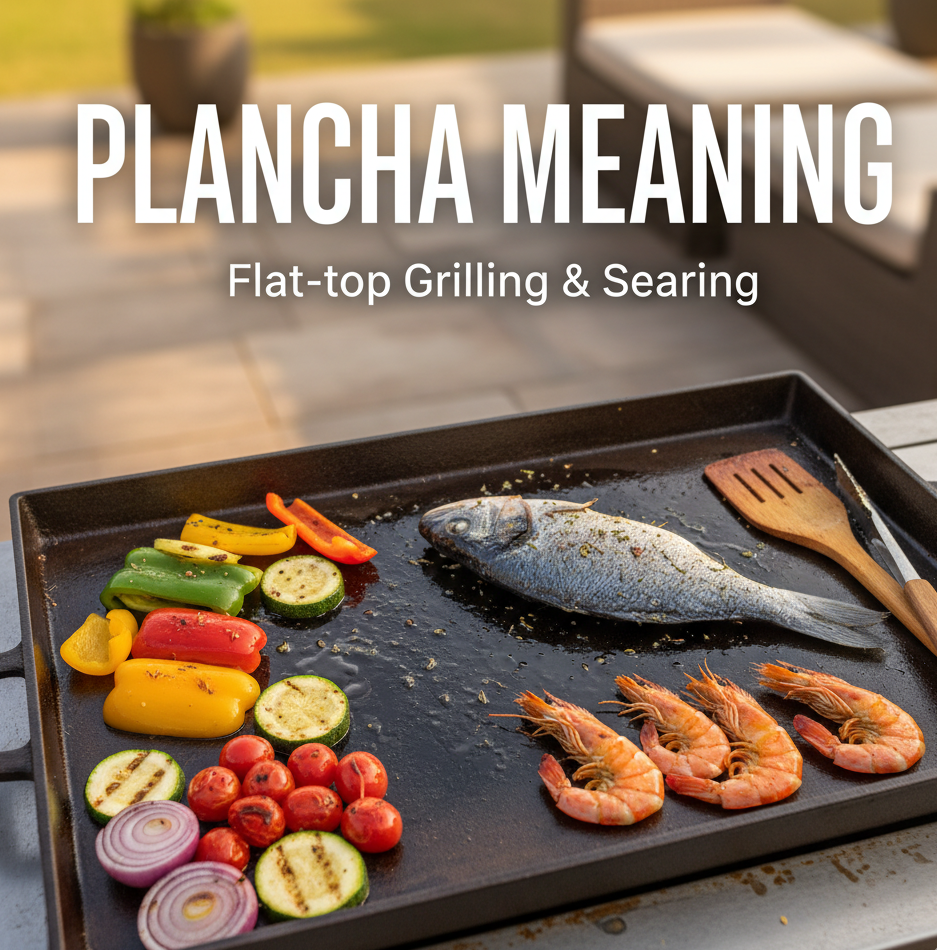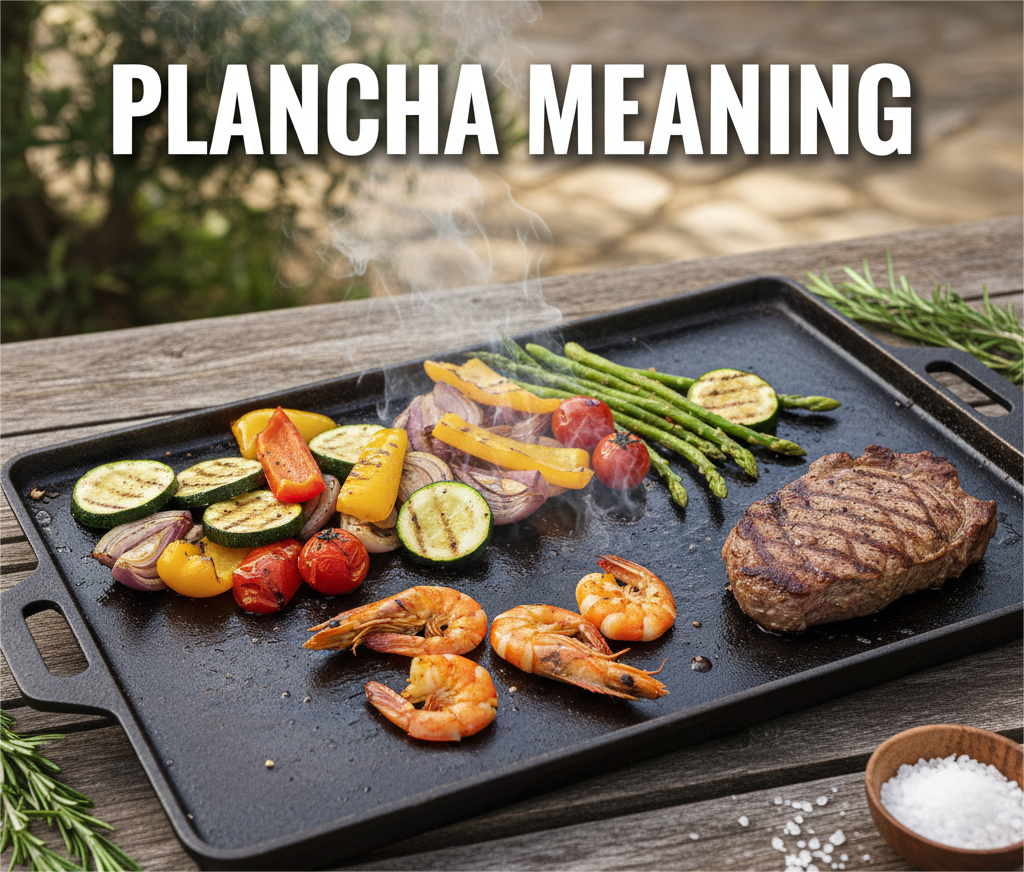The term “plancha meaning” may seem simple at first, but it carries a rich cultural and culinary significance. In Spanish, a plancha refers to a flat metal plate or griddle used for cooking, while the phrase “a la plancha” describes a popular technique of grilling food quickly at high heat.
Understanding plancha meaning goes beyond translation—it reveals a cooking method that enhances flavors, preserves nutrients, and has become a symbol of communal dining in many cultures. In this article, we will explore the full scope of plancha meaning, its applications in the kitchen, modern variations, and why it is gaining popularity worldwide.
Table of Contents
What Does “Plancha Meaning”?
The literal meaning of plancha in Spanish is “iron” or “metal plate.” Depending on the context, it can also refer to a sheet or plate of metal. While this is the literal translation, the word has become most widely recognized in its culinary form.
- In cooking: Plancha refers to a flat-top grill or griddle. Foods are cooked on a very hot metal surface, often with little to no oil.
- In everyday life: In some contexts, plancha can also mean a flat iron for pressing clothes.
This versatility makes the term interesting and adaptable in multiple domains. In the culinary world, “a la plancha” is a technique that highlights simplicity, speed, and flavor.
A La Plancha: The Cooking Technique
The phrase “a la plancha” translates to “on the griddle” or “grilled on a metal plate.” This cooking method is especially popular in Spanish and Latin American cuisine. The technique involves using a flat, hot metal surface to cook food quickly at high temperatures.
Characteristics of Cooking A La Plancha
- Quick Searing: The high heat of the plancha sears the exterior while keeping the interior tender.
- Minimal Oil: Very little oil is required, which makes it a healthy cooking method.
- Even Cooking: The flat surface ensures uniform heat distribution, perfect for delicate foods.
Foods Commonly Cooked A La Plancha
- Seafood: Shrimp, fish fillets, and scallops are frequently cooked using this technique.
- Meats: Beef, chicken, and pork can be seared on a plancha for rich flavors.
- Vegetables: Peppers, onions, mushrooms, and asparagus cook beautifully, retaining their natural sweetness.
This method preserves the natural flavors of ingredients, making it a favorite for chefs and home cooks alike.
The Cultural Significance of Plancha
Plancha is more than just a cooking technique; it represents a cultural tradition. It is often associated with communal meals, outdoor gatherings, and casual dining.
Spanish Cuisine
In Spain, cooking gambas a la plancha (grilled prawns) or filetes a la plancha (grilled fillets) is a social event. People gather around the plancha, share food, and enjoy conversation.
Latin American Influence
In countries like Mexico and Argentina, the plancha technique has inspired similar cooking methods. For example:
- Comal in Mexico: A flat, round griddle used for tortillas and roasting vegetables.
- Chapa in Argentina: A metal plate used for grilling meats outdoors.
The plancha, therefore, is not just about cooking—it is a symbol of communal dining, sharing, and enjoyment of fresh, simple ingredients.

Modern Planchas and Their Variations
Today, planchas are available in many modern forms, making them accessible to home cooks and professionals alike.
Types of Planchas
- Electric Plancha: Perfect for indoor cooking; maintains consistent heat.
- Gas Plancha: Ideal for outdoor use; reaches very high temperatures for perfect searing.
- Portable Plancha: Compact and lightweight; convenient for picnics or camping trips.
Features to Look For
- Non-Stick Surfaces: Easier cleaning and better cooking results.
- Temperature Control: Ensures precise cooking for different foods.
- Size Options: Single-plate for home use, large planchas for gatherings.
The versatility of modern planchas allows anyone to enjoy authentic a la plancha cooking at home, whether grilling seafood, meats, or vegetables.
Benefits of Cooking A La Plancha
Cooking a la plancha offers several advantages that make it stand out among other methods:
- Healthier Cooking: Minimal oil preserves nutrients and reduces calories.
- Enhanced Flavor: Searing locks in juices and natural flavors.
- Quick and Efficient: High heat ensures fast cooking without overcooking the food.
- Versatility: Works with seafood, meats, and vegetables alike.
Common Mistakes to Avoid
Even though plancha cooking is simple, some mistakes can affect results.
- Overcrowding the Plancha: Too many items reduce heat efficiency, leading to uneven cooking.
- Using Excessive Oil: Over-oiling can cause sticking and smoky flavors.
- Not Preheating Properly: The plancha must be hot enough to sear food correctly.
- Neglecting Cleaning: Residue from previous meals can stick to the surface and affect flavor.
Following these tips ensures a perfect a la plancha experience every time.
Plancha in Everyday Life
While primarily known for cooking, the word plancha also refers to everyday objects like a flat iron. In Spanish, people say “poner la ropa a la plancha” to mean “iron the clothes.”
This dual meaning adds an interesting layer, showing how a single term can bridge culinary, domestic, and cultural contexts.
Why Plancha is Trending Globally
The plancha technique has grown beyond Spain and Latin America due to several reasons:
- Health Trends: People prefer minimal-oil cooking methods.
- Gourmet Appeal: Restaurants and chefs emphasize clean flavors with searing techniques.
- Ease of Use: Modern planchas are easy to operate and clean.
- Visual Appeal: Grilled foods on a flat surface look attractive and appetizing.
The trend is especially popular in home kitchens, outdoor dining, and food festivals.
Tips for Perfect Plancha Cooking at Home
- Preheat the Plancha: Always wait until the surface is very hot.
- Season Lightly: Use salt, pepper, and minimal oil to enhance flavors.
- Use Fresh Ingredients: High-quality seafood and vegetables work best.
- Cook in Batches: Avoid overcrowding to maintain even heat.
- Experiment with Marinades: Citrus, herbs, and spices add delicious variations.
By following these tips, anyone can master plancha cooking and enjoy restaurant-quality dishes at home.
Plancha Recipes to Try
1. Shrimp A La Plancha
- Toss shrimp with olive oil, garlic, and paprika.
- Cook for 2-3 minutes per side on a hot plancha.
- Serve with fresh lemon wedges.
2. Vegetables A La Plancha
- Slice peppers, zucchini, and mushrooms.
- Drizzle with olive oil and season with salt.
- Cook until slightly charred and tender.
3. Steak A La Plancha
- Season fillets with salt and pepper.
- Sear on each side for 3-5 minutes depending on thickness.
- Let rest before serving.

Conclusion
The term plancha is more than just a word—it embodies a rich culinary tradition, cultural significance, and modern convenience. From simple definitions to sophisticated cooking techniques, a la plancha offers a healthy, flavorful, and efficient way to prepare food. Whether you are searing seafood, grilling meats, or roasting vegetables, the plancha method brings taste, tradition, and communal enjoyment to every meal.
By understanding the full meaning of plancha and mastering its techniques, anyone can elevate their cooking, embrace cultural traditions, and enjoy delicious meals in the comfort of home.
